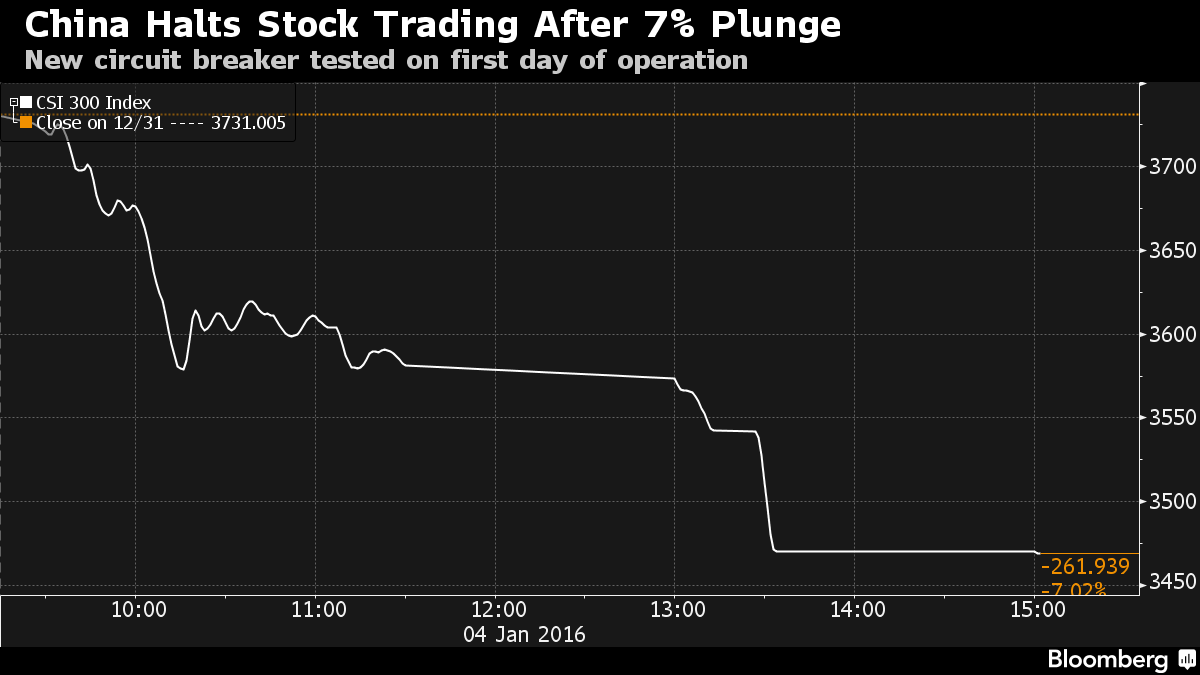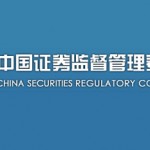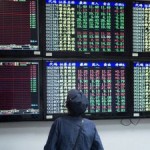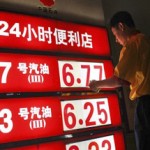China Halts Stock Trading After 7% Rout Triggers Circuit Breaker
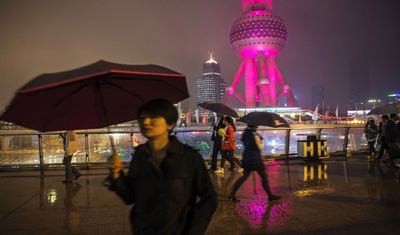
-
Weak manufacturing data, end to share-sale ban sparked rout
-
Stocks in Hong Kong extend retreat after mainland halt
The world’s second-largest stock market began the year on a down note after data showed manufacturing contracted for a fifth straight month and investors anticipated the end of a ban on share sales by major stakeholders at the end of this week. Chinese policy makers, who went to unprecedented lengths to prop up stock prices during a summer rout, are trying to prevent financial-market volatility from weighing on economy set to grow at its weakest annual pace since 1990.
“This is a pretty dramatic start of trading for the year,” said Khiem Do, the Hong Kong-based head of multi-asset strategy at Baring Asset Management, which manages about $45 billion. “Some investors may have been unwinding their positions when trading volumes were light. That could have exaggerated the moves. The market has been very difficult to predict.”
Ripple Effect
Monday’s selloff rippled through regional equity markets, with Asian shares and U.S. equity-index futures extending losses. Chinese stocks’ influence on global markets has increased after the nation’s $5 trillion equity market rout, from mid-June through August, rattled investor confidence in the world’s second-largest economy.
Brokerages were prepared for the circuit breakers after conducting tests on the new mechanism last month, according to William Wong, the head of sales trading at Shenwan Hongyuan Group Co. in Hong Kong. About 595 billion yuan ($89.9 billion) of shares changed hands on mainland exchanges before the suspension, versus a full-day average of about 1 trillion yuan over the past year, according to data compiled by Bloomberg.
Herd Behavior
Under the circuit breaker rules finalized last month, a move of 5 percent in the CSI 300 triggers a 15-minute halt for stocks, options and index futures, while a move of 7 percent closes the market for the rest of the day. The CSI 300, comprised of large-capitalization companies listed in Shanghai and Shenzhen, fell as much as 7.02 percent before trading was suspended. The Shanghai Composite Index lost 6.9 percent.
Individual investors in China, who drive more than 80 percent of trading, may have rushed to sell after the first circuit breaker took effect to avoid getting stuck in positions by the 7 percent suspension, according to Andrew Sullivan, managing director for sales trading at Haitong International Securities Group in Hong Kong. It took just seven minutes for the second halt to come into effect as shares tumbled after the first suspension ended, according to data compiled by Bloomberg.
Chinese shares listed in Hong Kong, which aren’t affected by the circuit breakers, extended losses after the halt on mainland exchanges. The Hang Seng China Enterprises Index retreated as much as 4.4 percent, before closing 3.6 percent lower.
Selling Overhang
“Investors are using Hong Kong to hedge their positions,” said Castor Pang, head of research at Core-Pacific Yamaichi Hong Kong. “The circuit breaker may increase selling pressure further.”
China’s first economic reports of 2016 showed a series of interest-rate cuts and increased fiscal stimulus have failed to boost flagging growth by the nation’s manufacturers. The private Caixin China Manufacturing purchasing managers’ index decreased to 48.2 last month, down from a five-month high of 48.6 in November. An official PMI reading released on Friday also showed a contraction, while a gauge of services rose to the highest since August 2014.
Traders are “bearish” after the manufacturing index readings, Wong said. “Investors are also concerned that a removal of major shareholders’ selling ban would weigh on indexes.”
Vulnerable Stocks
Goldman Sachs Group Inc. estimates the sales ban — imposed at the height of last year’s equity rout — kept $185 billion of shares off the market. Technology companies are the most vulnerable to a sell-off once the restriction is removed after they led a rebound since the benchmark index’s August low, according to Baptized Capital.
The China Securities Regulatory Commission announced July 8 that investors with holdings exceeding 5 percent, along with corporate executives and directors, would be prohibited from selling stakes for six months. The rule, which followed the suspension of initial public offerings and curbs on short-selling, was intended to stabilize capital markets amid an “unreasonable plunge” in share prices, according to the securities regulator. The CSRC hasn’t yet specified whether the ban will be lifted.
“There will be greater pressure from institutional investors once the ban on share sales is lifted,” Pang said. The government probably didn’t intervene to prop up shares today “as it needs to see how the market will cope with new changes in trading system.”
Source: Bloomberg – China Halts Stock Trading After 7% Rout Triggers Circuit Breaker









